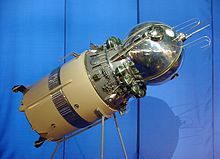 The space suit worn by Alexei Leonov on the first human space walk. On display at the Smithsonian National Air and Space Museum. Author: Nijuuf
The space suit worn by Alexei Leonov on the first human space walk. On display at the Smithsonian National Air and Space Museum. Author: Nijuuf
This is the rest of Tuesday’s post. If you haven’t read it yet, take the time to do so, or this won’t make much sense.
Alexey Leonov had extreme difficulty reentering the airlock. His space suit had over inflated; the boots and gloves had slipped beyond his toes and fingertips, and his suit had increased in girth. He had to vent part of his rapidly depleting oxygen in order to bring his suit down in size, and even then he entered the airlock head first, instead of feet first as planned. Once inside the airlock, he had extreme difficulty contorting his body to close the outer door. All this time, his body was heating up dangerously; surrounded by vacuum, there was nothing to carry away the heat his body was generating.
Once air pressure had been restored in the airlock, Belyayev opened the inner door and Leonov was safe. For the moment. As he said in an article for Smithsonian’s Air and Space magazine in 2005, “the difficulties I experienced reentering the spacecraft were just the start of a series of dire emergencies that almost cost us our lives.”
The mission had achieved it’s goal and it was time to return, but just before the scheduled time for firing retro rockets the cosmonauts discovered that their automatic guidance system was malfunctioning. It took time to prepare for manual entry, so they had to wait one orbit, which would make them miss their return point by a thousand miles. (To find out why it would be a thousand miles, see the post coming on March 25.) Most of that orbit they were out of radio communications. (The Americans had built a string of radio relay stations around the world to maintain constant communication with their astronauts, but the Soviets had not.)
When communications were restored, ground control asked them where they had landed.
Their orbital path was set; the moment of firing their retro rockets would determine where on that orbit they would land. They chose a target just past the Urals. Using the clumsy and difficult manual backup equipment, they achieved the correct attitude and fired the retro rockets in the conical rear portion of the craft called the orbital module. The orbital and landing modules were supposed to separate ten seconds after retrofire. They didn’t.
The two cosmonauts knew immediately that something was terribly wrong. Instead of the steady press of force against their backs as they decelerated, they found themselves whipped about by confused forces that exceeded ten gravities. A communication cable between the two modules had failed to release, and now both modules were whipping about each other, tethered by the cable.
Finally, about 60 miles up, the cable burned through and the cosmonauts were freed. The drogue chute deployed, and then the main. All was peaceful and in order – briefly. Then it became dark as they dropped below cloud cover, the final rocket fired to slow them to landing speed, and they touched down in six feet of snow.
They were 1200 miles beyond their intended landing point.
They blew the explosive bolts to release the hatch. It didn’t open. They had landed in the middle of a forest and the hatch was held shut by a tree. By yanking violently they dislodged it and it fell away, lost in the snow.
They made their way out of the spacecraft and waded through snow to a small clearing. Those back at headquarters had not heard their landing signal, but a passing cargo plane had. It circled, and was soon joined by other planes and helicopters, but none of them could land in the rough taiga. Pilots threw a bottle of cognac; it broke. They threw warm clothing which got caught in the trees, but at least two pairs of wolfskin boots made it to the ground.
The light was failing. The cosmonauts returned to their craft for shelter. Leonov was walking in calf deep sweat still trapped in his space suit from his space walk. Both cosmonauts stripped, removed the liners from their space suits and wrung them dry, then put the on again along with the wolf skin boots. They abandoned the useless space suits and crawled into the landing module for the night, well aware that the taiga was filled with bears and wolves, and that this was mating season, when they were most aggressive.
The hatch was out of reach. The lights failed, but the circulation fan ran all night, adding to their misery. The temperature dropped to 22 below zero.
A rescue party arrived on skis the next morning; they chopped trees to build a small log cabin and a big fire. The cosmonauts spent a second night, then skied out to where a second, larger party had chopped down enough trees for a helicopter to land.
I guess they made ‘em tough in those days. I suspect they still do.


 photo taken from Apollo 8
photo taken from Apollo 8

